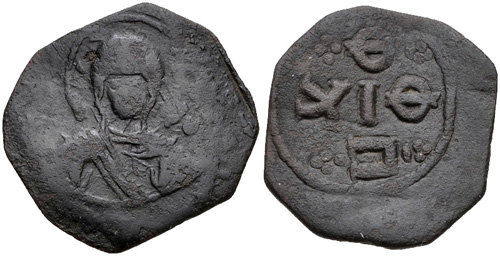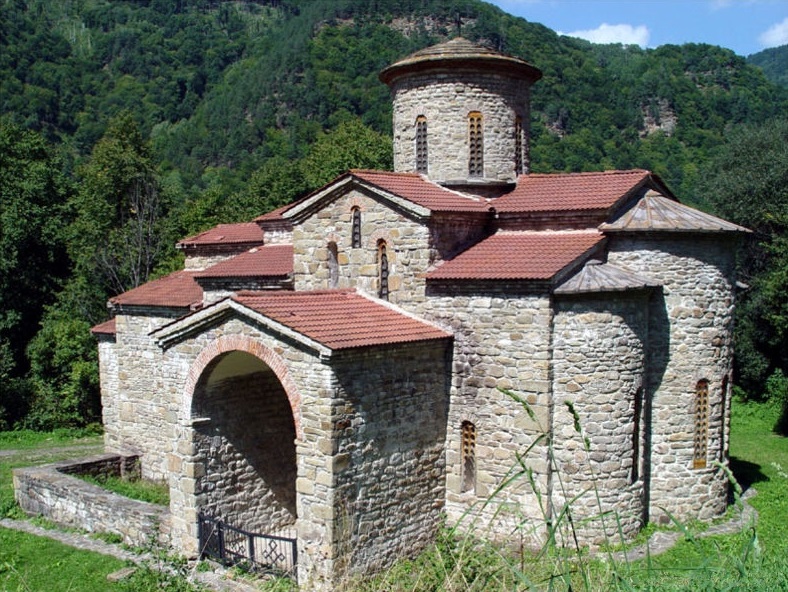|
Theodore Gabras
Theodore Gabras ( el, Θεόδωρος Γαβρᾶς) was a Byzantine governor in the Pontus who was involved in a minor unsuccessful rebellion against the Emperor Alexios I Komnenos around the year 1091. Theodore Gabras is an Eastern Orthodox martyr whose feast day is celebrated on 2 October. Early life Theodore originally hailed from the Theme of Chaldia, and spent most of his adult life serving in the Byzantine army. A violent and energetic man, he had gained considerable fame as a gifted soldier, both courageous and cunning, with an outstanding record of success. It was reported that he rarely failed in any military task, and invariably got the better of his enemies. Already by 1067, when he commissioned a gospel preserved in St Petersburg, he had risen to the ranks of ''patrikios'', ''topoteretes'' and ''hypatos''. His crowning glory was the recapture of Trebizond from the Seljuk Turks during the 1080s, which he ruled for a time as if it were his own personal fiefdom. By th ... [...More Info...] [...Related Items...] OR: [Wikipedia] [Google] [Baidu] |
Byzantine Empire
The Byzantine Empire, also referred to as the Eastern Roman Empire or Byzantium, was the continuation of the Roman Empire primarily in its eastern provinces during Late Antiquity and the Middle Ages, when its capital city was Constantinople. It survived the fragmentation and fall of the Western Roman Empire in the 5th century AD and continued to exist for an additional thousand years until the fall of Constantinople to the Ottoman Empire in 1453. During most of its existence, the empire remained the most powerful economic, cultural, and military force in Europe. The terms "Byzantine Empire" and "Eastern Roman Empire" were coined after the end of the realm; its citizens continued to refer to their empire as the Roman Empire, and to themselves as Romans—a term which Greeks continued to use for themselves into Ottoman times. Although the Roman state continued and its traditions were maintained, modern historians prefer to differentiate the Byzantine Empire from Ancient ... [...More Info...] [...Related Items...] OR: [Wikipedia] [Google] [Baidu] |
Alania
Alania was a medieval kingdom of the Iranian Alans (proto-Ossetians) that flourished in the Northern Caucasus, roughly in the location of latter-day Circassia, Chechnya, Ingushetia, and modern North Ossetia–Alania, from its independence from the Khazars in the late 9th century until its destruction by the Mongol invasion in 1238–39. Its capital was Maghas, and it controlled a vital trade route through the Darial Pass. The kingdom reached its peak in the 11th century, under the rule of king Durgulel. Name The name ''Alania'' derives from the Old Iranian stem *''Aryāna-'', a derivative form of the Indo-Iranian stem *''arya''- (' Aryan'). It is cognate with the name of Iran (''Ērān''), which stems from the Old Persian ''*Aryānām'' ('of the Aryans')''.'' History The Alans (Alani) originated as an Iranian-speaking subdivision of the Sarmatians. They were split by the invasion of the Huns into two parts, the European and the Caucasian. The Caucasian Alans occupi ... [...More Info...] [...Related Items...] OR: [Wikipedia] [Google] [Baidu] |
First Crusade
The First Crusade (1096–1099) was the first of a series of religious wars, or Crusades, initiated, supported and at times directed by the Latin Church in the medieval period. The objective was the recovery of the Holy Land from Islamic rule. While Jerusalem had been under Muslim rule for hundreds of years, by the 11th century the Seljuk takeover of the region threatened local Christian populations, pilgrimages from the West, and the Byzantine Empire itself. The earliest initiative for the First Crusade began in 1095 when Byzantine emperor Alexios I Komnenos requested military support from the Council of Piacenza in the empire's conflict with the Seljuk-led Turks. This was followed later in the year by the Council of Clermont, during which Pope Urban II supported the Byzantine request for military assistance and also urged faithful Christians to undertake an armed pilgrimage to Jerusalem. This call was met with an enthusiastic popular response across all social clas ... [...More Info...] [...Related Items...] OR: [Wikipedia] [Google] [Baidu] |
Plovdiv
Plovdiv ( bg, Пловдив, ), is the second-largest city in Bulgaria, standing on the banks of the Maritsa river in the historical region of Thrace. It has a population of 346,893 and 675,000 in the greater metropolitan area. Plovdiv is the cultural capital of Bulgaria and was the European Capital of Culture in 2019. It is an important economic, transport, cultural, and educational center. Plovdiv joined the UNESCO Global Network of Learning Cities in 2016. Plovdiv is situated in a fertile region of south-central Bulgaria on the two banks of the Maritsa River. The city has historically developed on seven syenite hills, some of which are high. Because of these hills, Plovdiv is often referred to in Bulgaria as "The City of the Seven Hills". There is evidence of habitation in the area dating back to the 6th millennium BCE, when the first Neolithic settlements were established. The city was subsequently a local Thracian settlement, later being conquered and ruled also by Persia ... [...More Info...] [...Related Items...] OR: [Wikipedia] [Google] [Baidu] |
Euxine
The Black Sea is a marginal mediterranean sea of the Atlantic Ocean lying between Europe and Asia, east of the Balkans, south of the East European Plain, west of the Caucasus, and north of Anatolia. It is bounded by Bulgaria, Georgia, Romania, Russia, Turkey, and Ukraine. The Black Sea is supplied by major rivers, principally the Danube, Dnieper, and Don. Consequently, while six countries have a coastline on the sea, its drainage basin includes parts of 24 countries in Europe. The Black Sea covers (not including the Sea of Azov), has a maximum depth of , and a volume of . Most of its coasts ascend rapidly. These rises are the Pontic Mountains to the south, bar the southwest-facing peninsulas, the Caucasus Mountains to the east, and the Crimean Mountains to the mid-north. In the west, the coast is generally small floodplains below foothills such as the Strandzha; Cape Emine, a dwindling of the east end of the Balkan Mountains; and the Dobruja Plateau considerably fart ... [...More Info...] [...Related Items...] OR: [Wikipedia] [Google] [Baidu] |
Pharus (town) , Greek colony on the Adriatic island of Hvar
{{disambig, genus ...
Pharus may refer to: * ''Pharus'' (bivalve), a genus of bivalves in the family Pharidae * ''Pharus'' (plant), a genus of grasses * Pharos, Greek name for lighthouses, used for: ** Pharos of Alexandria ** Pharus (colony) Hvar (; Chakavian: ''Hvor'' or ''For'', el, Φάρος, Pharos, la, Pharia, it, Lesina) is a Croatian island in the Adriatic Sea, located off the Dalmatian coast, lying between the islands of Brač, Vis and Korčula. Approximately long ... [...More Info...] [...Related Items...] OR: [Wikipedia] [Google] [Baidu] |
Sosthenium
Lasthenes ( grc, Λασθένης) or Leosthenion (Λεωσθένιον) or Sosthenion (Σωσθένιον) was a town of ancient Thrace, inhabited during Roman and Byzantine times. Its site is located near İstinye in European Turkey East Thrace or Eastern Thrace ( tr, Doğu Trakya or simply ''Trakya''; el, Ανατολική Θράκη, ''Anatoliki Thraki''; bg, Източна Тракия, ''Iztochna Trakiya''), also known as Turkish Thrace or European Turkey, is the pa .... References Populated places in ancient Thrace Former populated places in Turkey Roman towns and cities in Turkey Populated places of the Byzantine Empire History of Istanbul Province {{Istanbul-geo-stub ... [...More Info...] [...Related Items...] OR: [Wikipedia] [Google] [Baidu] |
Follis Of Theodore Gabras
The follis (plural ''folles''; it, follaro, ar, فلس, Fels) was a type of coin in the Roman and Byzantine traditions. Roman coin In the past, the term ''follis'' was used to describe a large bronze Roman coin introduced in about 294 (the actual name of this coin is unknown) at the time of the coinage reform of Diocletian. It weighed about 10 grams and was about 4% silver, mostly as a thin layer on the surface. However, later studies have shown that this is wrong, and that this coin may have been known as a "nummus". The word ''follis'' means bag (usually made of leather) in Latin, and there is evidence that this term was used in antiquity for a sealed bag containing a specific amount of coinage. It has also been suggested that the coin was named Follis because of the ancient Greek word "φολίς" meaning a thin layer of metal (''cf.'' Latin ''folium'', "leaf") which covers the surface of various objects, since originally, this coin had a thin layer of silver on top. ... [...More Info...] [...Related Items...] OR: [Wikipedia] [Google] [Baidu] |
Maria Of Alania
Maria of Alania (born Martha; ka, მართა; 1053–1118) was Byzantine empress by marriages to emperors Michael VII Doukas and Nikephoros III Botaneiates. Her status as empress was considered a significant success for a newly unified Kingdom of Georgia, which would achieve regional influence comparable to that of Byzantium only during the reign of Martha's nephew, King David IV, who refused to carry a Byzantine title. Maria was the only foreign Byzantine empress of the eleventh century. Early years A daughter of the Georgian monarch Bagrat IV, Martha, at the age of 5 years, was sent as a hostage to Constantinople to ensure her father's good behavior and further her education at the Byzantine court under the patronage of Empress Theodora in 1056. The latter, however, died later in the year and Martha returned home to Georgia. Empress of Michael VII Doukas In 1065 she married the future emperor Michael, a son of Constantine X Doukas, and became an empress when Micha ... [...More Info...] [...Related Items...] OR: [Wikipedia] [Google] [Baidu] |
Bagrat IV Of Georgia
Bagrat IV ( ka, ბაგრატ IV; 101824 November 1072), of the Bagrationi dynasty, was the King of Georgia from 1027 to 1072. During his long and eventful reign, Bagrat sought to repress the great nobility and to secure Georgia's sovereignty from the Byzantine and Seljuq Empires. In a series of intermingled conflicts, Bagrat succeeded in defeating his most powerful vassals and rivals of the Liparitid family, bringing several feudal enclaves under his control, and reducing the kings of Lorri and Kakheti, as well as the emir of Tbilisi to vassalage. Like many medieval Caucasian rulers, he bore several Byzantine titles, particularly those of '' nobelissimos'', '' curopalates'', and ''sebastos''. Early reign Bagrat was the son of the king George I () by his first wife Mariam of Vaspurakan. At the age of three, Bagrat was surrendered by his father as a hostage to the Byzantine emperor Basil II () as a price for George's defeat in the 1022 war with the Byzantines. The you ... [...More Info...] [...Related Items...] OR: [Wikipedia] [Google] [Baidu] |
Mariam (daughter Of Bagrat IV Of Georgia)
Mariam ( ka, მარიამი) was a daughter of King Bagrat IV of Georgia Bagrat IV ( ka, ბაგრატ IV; 101824 November 1072), of the Bagrationi dynasty, was the King of Georgia from 1027 to 1072. During his long and eventful reign, Bagrat sought to repress the great nobility and to secure Georgia's sovereign ... (reign, r. 1027–1072) by his Alania, Alan wife Borena of Alania, Borena. She was possibly married, as the second wife, to the Byzantine Empire, Byzantine dignitary Theodore Gabras. Mariam was mentioned in the Georgian Chronicles, Georgian annals on one occasion only as being present at the deathbed of her father Bagrat IV in November 1072.Lynda Garland & Stephen Rapp. ''Mary 'of Alania': Woman and Empress Between Two Worlds'', p. 103. In: Lynda Garland (ed., 2006), ''Byzantine Women: Varieties of Experience, 800-1200''. Ashgate Publishing, Ltd., . The name Mariam (Maria) was also borne—as a Byzantine empress—by Bagrat's other, better-documented daug ... [...More Info...] [...Related Items...] OR: [Wikipedia] [Google] [Baidu] |





.jpg)